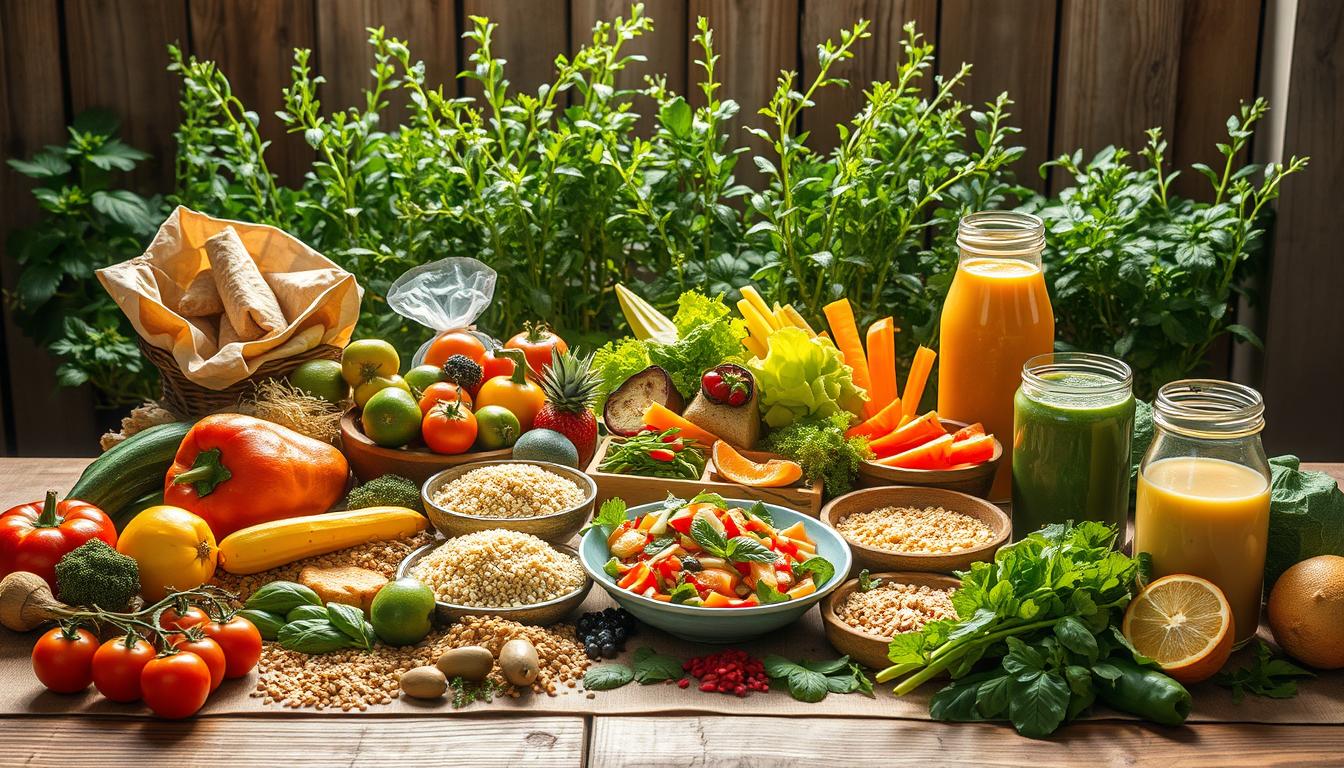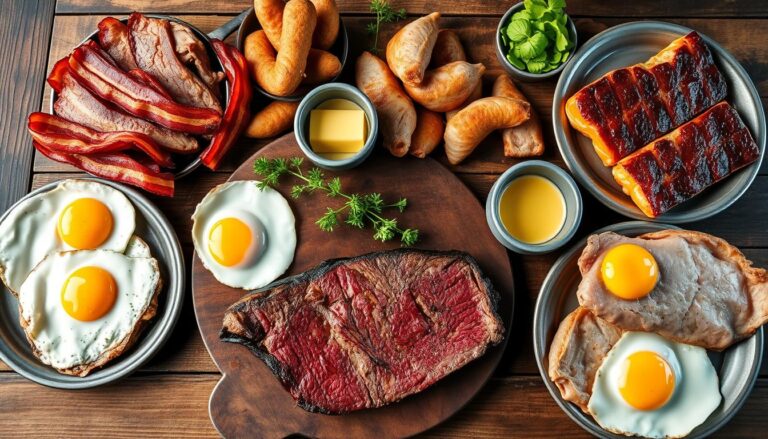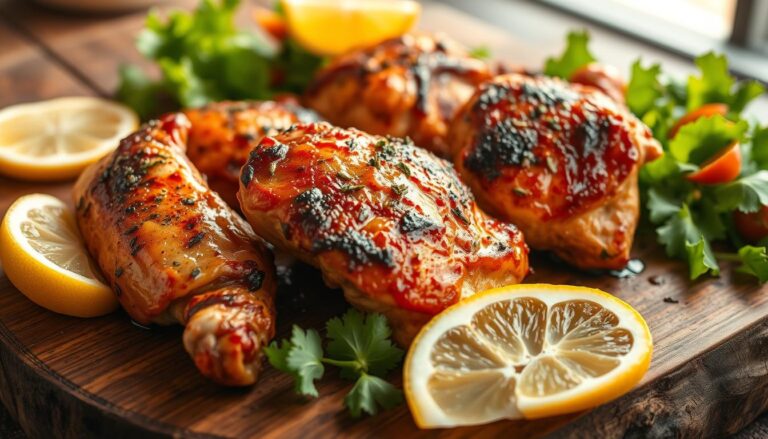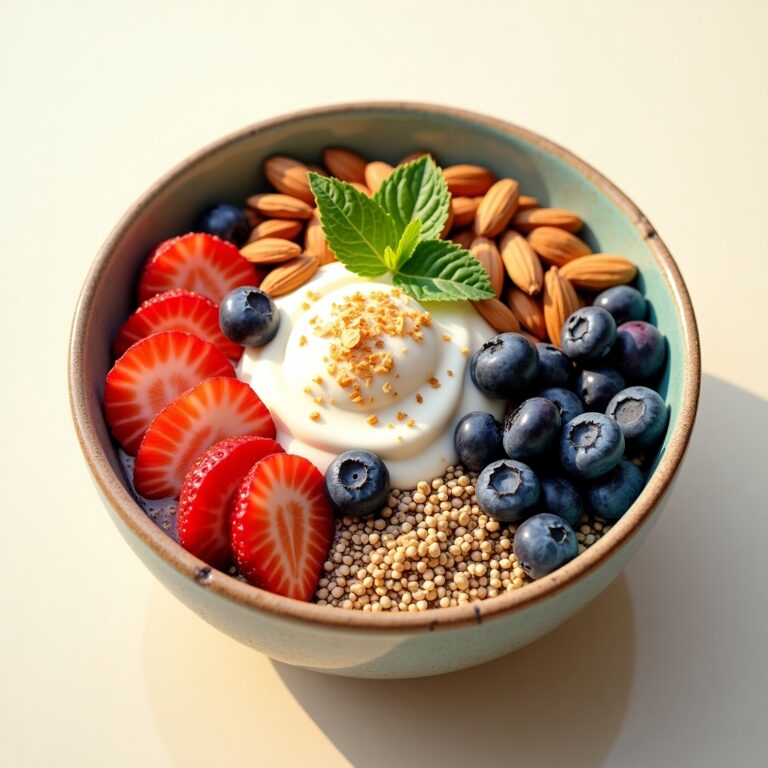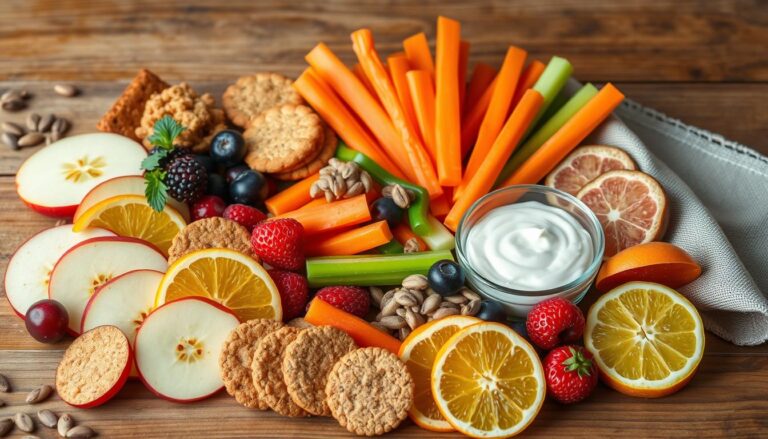Explore Tasty Special Diets Recipes for Wellness
Eating a balanced diet is crucial for maintaining overall wellness. With the rise of various dietary preferences and requirements, healthy recipes have become a staple for those seeking a healthier lifestyle.
Whether you’re looking to adopt a new wellness cooking routine or simply want to explore new flavors, our collection of special diets recipes is designed to inspire and nourish your body.
Key Takeaways
- Discover new healthy recipes for a balanced diet
- Explore the benefits of special diets for wellness
- Learn how to incorporate wellness cooking into your daily routine
- Find inspiration for new flavors and dietary preferences
- Nourish your body with our collection of special diets recipes
Understanding Special Diets and Their Health Benefits
With the rise of dietary restrictions and preferences, understanding special diets is crucial for making informed choices. Special diets are designed to address specific health needs or preferences, ranging from managing chronic conditions to aligning with personal beliefs.
Common Types of Special Diets in Modern Wellness
There are numerous special diets, each with its unique benefits. Some of the most common include gluten-free, ketogenic, vegan, and anti-inflammatory diets. These diets cater to various needs, such as managing celiac disease, achieving weight loss, or following a plant-based lifestyle.
How Dietary Choices Impact Long-term Health
Dietary choices play a significant role in long-term health. A well-chosen special diet can help manage or even reverse certain health conditions. For instance, a ketogenic diet has been shown to improve epilepsy symptoms, while an anti-inflammatory diet may help reduce chronic pain.
Identifying Your Personal Nutritional Needs
Understanding your personal nutritional needs is key to benefiting from a special diet. This involves considering factors such as age, health status, and lifestyle. Consulting with a healthcare professional or a registered dietitian can provide personalized guidance, ensuring that your dietary choices support your overall wellbeing.
By understanding the different types of special diets and their benefits, individuals can make informed decisions that enhance their health and quality of life.
Essential Kitchen Tools and Ingredients for Dietary Success
Dietary success starts in the kitchen with the right appliances and pantry staples. Having the correct tools and ingredients not only makes cooking easier but also ensures that you can adhere to your dietary requirements without sacrificing flavor or nutrition.
Must-Have Appliances for Diet-Specific Cooking
For those following special diets, certain appliances can make a significant difference. A high-quality blender is essential for keto-friendly smoothies, while a rice cooker can be a game-changer for gluten-free diets. Additionally, an instant pot can help prepare a variety of meals quickly, from soups to grains.
Pantry Staples for Various Dietary Restrictions
Stocking the right pantry staples is crucial. For gluten-free diets, this includes gluten-free flours and certified gluten-free grains. For keto diets, healthy oils like coconut and olive oil are must-haves. Common pantry staples across various diets include canned beans, nuts, and seeds.
Sourcing Quality Specialty Ingredients in the US
Finding the right ingredients can be challenging, but there are several options. Specialty grocery stores and online retailers often carry a wide range of products catering to different dietary needs. Local farmers’ markets can also be a great source for fresh, high-quality ingredients.
| Dietary Need | Essential Ingredient | Best Source |
|---|---|---|
| Gluten-Free | Gluten-Free Flours | Specialty Grocery Stores |
| Keto | Healthy Oils | Online Retailers |
| Vegan | Plant-Based Proteins | Local Farmers’ Markets |
Delicious Gluten-Free Recipes That Don’t Sacrifice Flavor
Discover the rich flavors and textures of gluten-free cooking without sacrificing taste. Gluten-free recipes have evolved significantly, offering a wide range of delicious and healthy options for those with dietary restrictions.
Fluffy Gluten-Free Pancakes and Breakfast Bowls
Start your day with fluffy gluten-free pancakes made from almond flour and topped with fresh fruits and maple syrup. Alternatively, create a nutritious breakfast bowl with quinoa, nuts, and dried fruits for a filling meal.
- Use almond flour or coconut flour for gluten-free pancakes.
- Add fresh fruits and nuts for added nutrition.
- Experiment with different sweeteners like maple syrup or honey.
Hearty Gluten-Free Pastas and Comfort Foods
Enjoy hearty gluten-free pastas made from rice or quinoa, paired with rich sauces and vegetables. For comfort food, try gluten-free mac and cheese or chicken pot pie.
- Cook gluten-free pasta according to package instructions.
- Pair with homemade sauces for a delicious meal.
- Experiment with different gluten-free flours for baking.
Gluten-Free Baking: Breads, Cookies, and Cakes
Gluten-free baking can be challenging, but with the right ingredients, you can create delicious breads, cookies, and cakes. Use a mix of gluten-free flours and don’t be afraid to experiment.
By incorporating these gluten-free recipes into your diet, you can enjoy a variety of flavors without compromising on taste or nutrition.
Keto-Friendly Meals for Energy and Weight Management
For individuals looking to optimize their energy and weight, keto-friendly meals offer a promising solution. The ketogenic diet, known for its low-carb and high-fat regimen, has been praised for its potential to enhance energy levels and support weight loss.
Quick Keto Breakfast Ideas Under 5g Carbs
Starting your day with a keto breakfast can set a positive tone for your energy and weight management goals. Some quick ideas include:
- Avocado and Bacon Omelette: A filling breakfast that’s rich in healthy fats.
- Keto Smoothie: Made with almond milk, protein powder, and spinach, this smoothie is both nutritious and low in carbs.
- Spinach and Feta Scramble: A simple, flavorful dish that’s perfect for busy mornings.
Satisfying Keto Lunch and Dinner Recipes
For lunch and dinner, keto-friendly recipes can be both satisfying and diverse. Consider trying:
- Grilled Salmon with Pesto Sauce: A dish rich in omega-3 fatty acids and flavor.
- Keto Lasagna: Made with zucchini noodles instead of traditional pasta, this version is a low-carb delight.
- Beef and Broccoli Stir-Fry: Cooked in a wok with healthy oils, this meal is quick and nutritious.
Fat Bombs and Keto Desserts Without Sugar Spikes
Keto desserts can be a great way to satisfy your sweet tooth without compromising your diet. Some ideas include:
- Fat Bombs: Made with coconut oil and cream, these are perfect for a quick energy boost.
- Keto Cheesecake: A delicious dessert made with almond flour crust and sweetened with natural sweeteners.
By incorporating these keto-friendly meals into your diet, you can enjoy a balanced and satisfying culinary experience while working towards your energy and weight management goals.
Popular Special Diets Recipes for Plant-Based Eating
Exploring the realm of plant-based eating reveals a diverse array of vegan meals and dairy-free sauces that can elevate any meal. This culinary journey is not just about adopting a diet; it’s about embracing a lifestyle that prioritizes health, sustainability, and compassion.
Plant-based eating has gained significant traction in recent years, with more individuals seeking vegan options that are both nutritious and flavorful. The versatility of plant-based cuisine allows for a wide range of creative expressions in the kitchen.
High-Protein Vegan Meals Without Supplements
One of the common misconceptions about vegan diets is that they lack sufficient protein. However, numerous plant-based foods are rich in protein, making it easy to maintain a balanced diet without supplements. Some examples include:
- Legumes such as lentils and chickpeas
- Nuts and seeds like almonds and chia seeds
- Whole grains like quinoa and farro
- Soy products including tofu and tempeh
These foods can be combined in various ways to create high-protein meals. For instance, a bowl of quinoa and black bean salad with roasted vegetables is not only protein-rich but also packed with fiber and vitamins.
Meaty-Tasting Plant-Based Main Dishes
The advancement in plant-based cuisine has led to the development of meaty-tasting main dishes that are surprisingly vegan. These dishes often utilize plant-based proteins and innovative cooking techniques to mimic the texture and flavor of meat.
Some popular options include vegan burgers made from black beans or mushrooms, and “chick’n” parmesan sandwiches using breaded and baked tofu. These dishes are not only satisfying but also cater to a variety of tastes and dietary preferences.
Creamy Dairy-Free Sauces, Dressings, and Desserts
Dairy-free sauces and desserts have become increasingly sophisticated, offering creamy textures without the need for dairy. Ingredients like coconut cream, cashew cream, and almond milk are used to create rich and indulgent treats.
| Dairy-Free Ingredient | Used In | Benefit |
|---|---|---|
| Coconut Cream | Sauces and Desserts | Rich, creamy texture |
| Cashew Cream | Dressings and Sauces | Smooth, velvety texture |
| Almond Milk | Beverages and Desserts | Low-calorie, versatile |
By incorporating these ingredients into your cooking and baking, you can enjoy a wide range of delicious and satisfying plant-based meals.
“The future of food is plant-based, and it’s not just about vegetarianism or veganism; it’s about creating a more sustainable food system.” –
Anti-Inflammatory Diet Recipes to Reduce Chronic Pain
For individuals battling chronic pain, an anti-inflammatory diet rich in specific nutrients can be a powerful tool. Chronic pain affects millions of people worldwide, impacting their quality of life and overall well-being. Incorporating anti-inflammatory recipes into your daily meals can help alleviate symptoms and promote health.
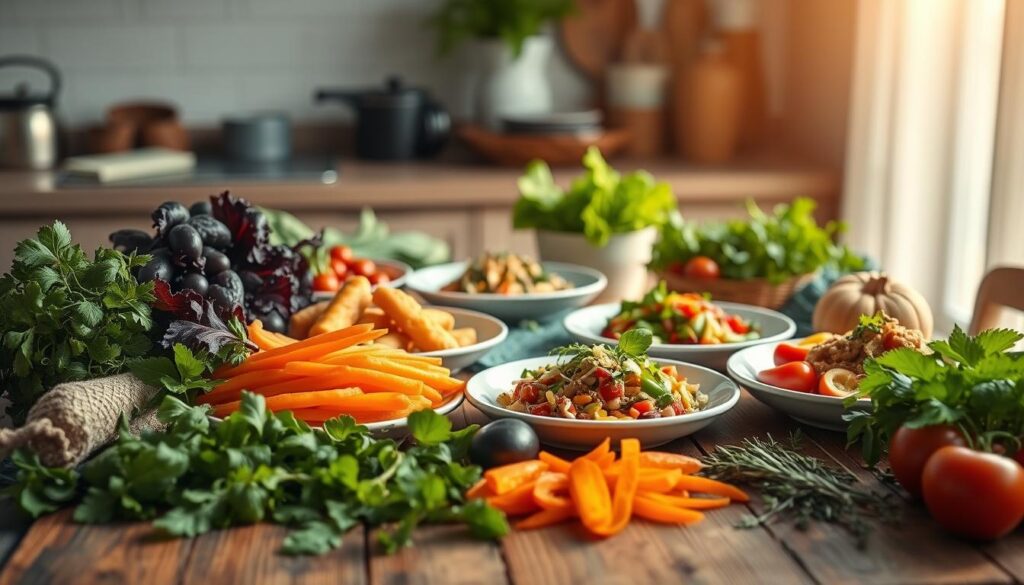
Golden Milk and Turmeric-Infused Healing Dishes
Turmeric, with its active compound curcumin, is renowned for its anti-inflammatory properties. “Turmeric is a potent anti-inflammatory agent, making it an excellent addition to dishes aimed at reducing chronic pain,” says a leading nutrition expert. Incorporating turmeric into your diet through Golden Milk or turmeric-infused dishes can be both delicious and therapeutic.
Some simple ways to include turmeric in your meals include:
- Adding turmeric to your morning smoothie or Golden Milk
- Using turmeric as a spice in soups and curries
- Making turmeric-infused tea or broth
Omega-3 Rich Meals for Joint Health and Mobility
Omega-3 fatty acids, particularly EPA and DHA, have been shown to reduce inflammation and promote joint health. Incorporating omega-3 rich foods into your diet can help alleviate chronic pain associated with joint inflammation. Fatty fish like salmon, sardines, and mackerel are excellent sources of omega-3s.
Some omega-3 rich meal ideas include:
- Grilled salmon with a side of steamed vegetables
- Sardine salad with mixed greens and a citrus vinaigrette
- Walnut and flaxseed-crusted tofu with roasted vegetables
Berry and Greens Recipes for Cellular Protection
Berries, such as blueberries and raspberries, are rich in antioxidants and have anti-inflammatory properties. Combining these with leafy greens like spinach and kale can enhance their benefits, providing cellular protection and reducing inflammation.
“A diet rich in fruits, vegetables, and whole grains can significantly reduce inflammation and promote overall health.”
Some berry and greens recipes to try:
- Blueberry and spinach smoothie bowl with almond milk and granola
- Raspberry and kale salad with a balsamic vinaigrette
- Mixed berry and green tea-infused chia seed pudding
Meal Prep Strategies for Special Dietary Needs
Preparing meals in advance is a game-changer for those with dietary restrictions. It not only saves time during the week but also ensures that nutritional needs are met without compromising on taste or variety.
Sunday Prep: 5 Days of Ready-to-Eat Special Diet Meals
Dedicate a day to preparing meals for the week ahead. For special diets, this could mean cooking a week’s worth of gluten-free lunches or portioning out keto-friendly dinners. Consider recipes that are easily reheated or can be taken on the go.
Freezer-Friendly Recipes That Maintain Texture and Flavor
Some meals freeze better than others. Look for recipes that are known to retain their texture and flavor after freezing and reheating. Soups, stews, and casseroles are great options for special diets.
Creating Balanced Nutrition Across Weekly Meal Plans
To ensure balanced nutrition, vary your meals across the week. Include a mix of proteins, healthy fats, and complex carbohydrates in your meal prep. The following table illustrates a sample meal plan:
| Day | Breakfast | Lunch | Dinner |
|---|---|---|---|
| Monday | Keto smoothie | Grilled chicken salad | Baked salmon |
| Tuesday | Gluten-free oatmeal | Turkey lettuce wraps | Shrimp stir-fry |
| Wednesday | Vegan pancakes | Quinoa and black bean bowl | Grilled chicken breast |
By incorporating these meal prep strategies, individuals with special dietary needs can enjoy a variety of healthy, delicious meals without the daily hassle of cooking.
Navigating Social Situations While Following Special Diets
Navigating social gatherings while adhering to special diets can be challenging, but with the right strategies, it’s entirely manageable. Social eating is an integral part of our culture, and being on a special diet shouldn’t make you feel excluded.
Restaurant Guide: Ordering Confidently With Restrictions
Dining out can be a breeze when you know how to navigate menus with your dietary needs in mind. Look for restaurants that offer special diet options and don’t hesitate to ask your server about ingredients and preparation methods. Many eateries now provide detailed nutritional information online, making it easier to choose a suitable meal.

Potluck-Perfect Dishes Everyone Will Love
Potlucks are a great way to share meals while sticking to your dietary restrictions. Opt for dishes that are naturally compliant with your diet, such as gluten-free casseroles or vegan salads. Labeling your dish can also help others with dietary restrictions identify what they can safely eat.
Handling Food Questions and Comments With Grace
When you’re on a special diet, it’s common to receive questions or comments about your food choices. Prepare a simple, gracious response to share with others, such as, “I’ve chosen this diet for my health, and I’m enjoying exploring new recipes.” This approach can help educate others and foster a supportive environment.
Conclusion: Embracing Wellness Through Mindful Eating
Mindful eating is a powerful tool for achieving overall wellness. By being more aware of our dietary choices, we can cultivate a healthier relationship with food and improve our overall health.
The special diets recipes and strategies outlined in this article provide a solid foundation for embracing mindful eating. From gluten-free and keto-friendly meals to plant-based and anti-inflammatory diets, there’s a wealth of options to explore.
By incorporating wellness cooking into our daily routine, we can take control of our nutritional well-being and make informed choices about the food we eat. Whether you’re looking to manage a specific dietary need or simply want to eat more mindfully, the right special diets recipe can make all the difference.
As you continue on your wellness journey, remember that mindful eating is a journey, not a destination. By being more intentional with our food choices, we can cultivate a deeper appreciation for the role that nutrition plays in our overall health and well-being.

